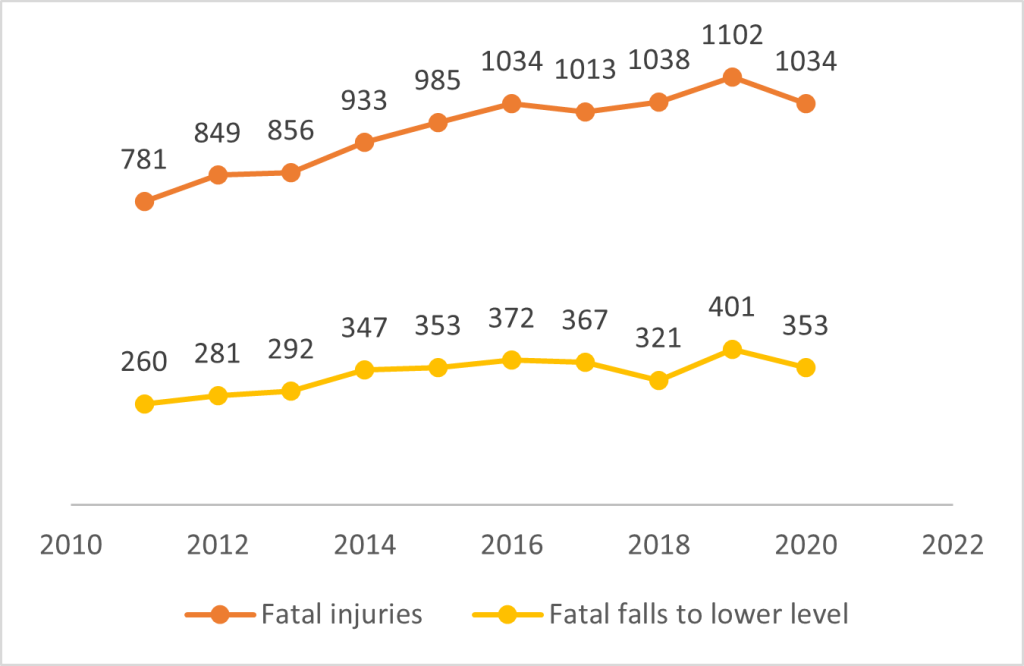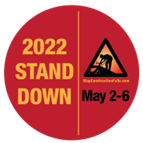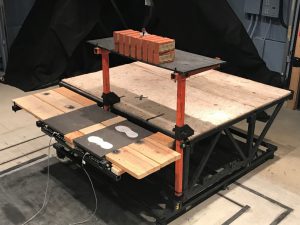Falls Campaign 2022: Making Research Work
Posted on by
Falls are the leading cause of death among construction workers. Tragically, each year roughly 300–400 construction workers fall to their deaths, most often while working at heights on roofs, ladders, and scaffolds. In 2020, out of 1,034 falls that resulted in death in the construction industry, 353 were due to falls from a height to a lower level. Researchers have found that some work conditions have higher risks for falls (CPWR 2021). Most fatal falls happen to roofing and finishing contractors in residential construction. Immigrant workers, workers for small construction companies, and younger/older workers also are at increased risk. Construction falls remain a persistent and deadly safety concern. From 2011–2021 the number of falls has increased. See Figure 1 below.
Figure 1. Fatal injuries and falls in the U.S. construction industry, 2011–2021

Many in the industry are making great efforts to address this tragedy with interventions that are known to be effective if used correctly. Evidence shows that many of the interventions that could be used to prevent falls are not being used or are not used correctly. The most common Occupational Safety and Health Administration (OSHA) citations are for violations related to fall protection (29 CFR 1926.501), scaffolding (29 CFR 1926.451), use of ladders (29 CFR 1926.1053), and fall protection training (29 CFR 1926.503) (OSHA, 2021).
In 2012 the National Occupational Research Agenda (NORA) Construction Sector Council launched the National Campaign to Prevent Falls in Construction with leadership from the National Institute for Occupational Safety and Health (NIOSH), the CPWR—The Center for Construction Research and Training and the Occupational Safety and Health Agency (OSHA). Each year, the campaign brings the industry together for a national safety stand-down.
National Safety Stand-Down to Prevent Falls in Construction
 This year’s National Safety Stand-Down to Prevent Falls in Construction will occur May 2–6, 2022. The goal of the Stand-Down is to raise awareness of fall hazards and reinforce safe work practices that help prevent fatalities and injuries related to falls. In a typical year, there are approximately 2,500 to 3,500 stand-down events held and nearly half a million workers reached based on OSHA certificate of participation data. Approximately 44% of the stand-downs involve companies with fewer than 20 employees.
This year’s National Safety Stand-Down to Prevent Falls in Construction will occur May 2–6, 2022. The goal of the Stand-Down is to raise awareness of fall hazards and reinforce safe work practices that help prevent fatalities and injuries related to falls. In a typical year, there are approximately 2,500 to 3,500 stand-down events held and nearly half a million workers reached based on OSHA certificate of participation data. Approximately 44% of the stand-downs involve companies with fewer than 20 employees.
Since its inception, the falls campaign has impacted tens of thousands of companies and millions of workers. Until recently, the Campaign primarily focused on holding a stand-down event the first week in May. In 2022, in addition to the annual falls stand-down event, we have placed greater emphasis on stand-down events throughout the year.
Year round planning for falls is crucial given the likely increase in construction work and hiring resulting from the $550 billion dollar infrastructure bill. The bill is expected to significantly increase construction activities to repair and replace highways, bridges, and roads. It will also include construction and maintenance of train tracks, power stations, and airport runways, taxiways and terminals. As work ramps up replacing and repairing our country’s infrastructure, it is important that all of this work be done SAFELY! Much of this activity will take place at heights and place workers at higher risk of falls.
While there are a number of known interventions, education and training programs, and workplace practices intended to eliminate construction falls, research is ongoing to further our understanding of the factors that may lead to falls. The following sections briefly describe selected current falls-related research occurring within NIOSH and the NIOSH National Construction Center: CPWR – The Center for Construction Research and Training.
The Fall Experience Survey
CPWR, working with the ANSI/ASSE Z359 National Work at Heights Task Force and the NORA Construction Sector Council Falls Work Group developed a “Fall Experience Survey” intended to improve our understanding of common underlying causes of falls from elevation. The survey was intended to (1) improve our understanding of industry needs, (2) guide the development of new materials supporting the Campaign, and 3) inform ANSI Z359 voluntary standards development.
CPWR received a total of 671 responses to the survey. Sixty four percent of the responses represented the construction industry. A total of 495 fall incidents were reported and approximately 27% of the reported falls were fatal. Approximately 49% of the falls involved reporting that no fall protection was used. Numerous underlying causes of falls were reported with the primary reported causes including: insufficient or ineffective planning, fall protection being supplied but not used, and fall protection was used improperly. Approximately 21% reported that no fall protection planning occurred at all.
Residential Roofing
Residential roofers work on sloped roof surfaces, which require multiple crossings. Research is ongoing to learn more about balance and stability of roofers as they perform their work. Roofers accounted for 874 out of the 2,013 (43%) fatal falls in the construction sector between 2011 and 2017 (CPWR 2019) . Additionally, U.S. roofers had the highest risk of fatal falls with 36 deaths per 100,000 full time employees (FTEs), which was ten times greater than the rate of all other construction occupations in the U.S. combined (CPWR 2019).
Sloped roof surfaces cause many changes in the way humans move that can lead to an increased risk of falls. Walking across a sloped roof surface decreases postural stability and results in greater sway compared to walking on a level surface. An increased sway in the front-back direction may cause slipping in that direction; and similarly in the side-to-side direction, fall risk is increased as there is more sway in the side-to-side direction, leading to more stress placed on the hip muscles in order to reduce falling (Breloff 2020). Walking across a sloped roof also changes the angles of the hip, knee, and ankles, as well as how the feet land on the ground compared to level surface walking. These physical changes can impede they body’s ability to sense movement, action, and location and can increase the risk of falling (Breloff 2019, 2022) .
It is important to make construction workers aware that the body is working extra hard to combat falling. In addition to wearing proper fall protection, workers should also wear the correct footwear, move slowly, walk with a wider stance, or use a zig-zagging pattern which can help alleviate the chance of falling.

Falls from Mast Climbers
Construction workers use mast climbing work platforms (MCWPs) to conduct a variety of masonry tasks on high rise buildings. Pan (2012, 2018a, 2018b) identified two primary hazards that workers on MCWPs are exposed to: falls and musculoskeletal disorders (MSDs). In 2021, NIOSH published research which quantified risks, from postural sway, unstable work surfaces, repetitive impact loadings, and awkward postures while laying bricks on a simulated elevated MCWP equipped with and without a “production table” (Pan et al., 2021). It is common practice for masons to store their bricks and other materials on the MCWP’s working platform while they work from the step deck near the relevant workspace (Pan et al. 2018b). Use of a production table allows workers to stage their work materials at about waist height to reduce bending and twisting of their torso. This study found that the use of a production table significantly reduced postural-sway and fall hazards while working on a MCWP as compared to using the traditional step-down configuration.
Traumatic Brain Injury and Helmets
Work-related traumatic brain injury is involved in approximately 20% of traumatic occupational injuries and 60% of work-related deaths in the state of Washington (Sears et al., 2013). Traumatic brain injury is thought to be one of the most serious workplace injuries (Konda et al., 2015; Tiesman et al., 2011). Construction helmets can provide personal protection to reduce traumatic brain injuries in construction. Shock absorption is a construction helmet’s most important performance parameter (Pan et al., 2020). Construction helmets have different suspension system designs and shock absorbing materials. Air-bubble cushions have been widely used in commercial packaging for shock absorption; however, air-bubble cushions have never been used in construction helmets. In 2021, NIOSH research (Air-bubble Cushioning Application to Improve Shock Absorption Performance of Construction and Industrial Helmets) found that adding an air-bubble cushioning liner to a Type I construction helmet will substantially increase shock absorption performance for large and repeated impacts (Wu et al., 2020; Wu et al., 2021). Recently, NIOSH assessed fall protection performance for construction helmets (Evaluation of the Fall Protection of Type I Industrial Helmets) and found that the material the helmet is impacting on had substantial effects on the risk of producing traumatic brain injury (Wu et al., 2022). This study also identified that some models of Type I helmets, provided a certain degree of fall protection. These findings may help manufacturers improve helmet design and reduce work-related traumatic brain injury.
High Winds
Working at elevation becomes even more dangerous during wind gusts and sustained high winds. It is important that construction crews routinely monitor weather conditions and broadcast channels. Adverse weather conditions can jeopardize the health and safety of construction workers.
The NIOSH Fatality Assessment and Control Evaluation (FACE) program has identified high winds as a contributing factor in some of their fatality investigations (FACE 2013, 2019). Even at ground level, high wind gusts can be dangerous. Wind speeds increase with elevation making it even more dangerous as height increases. Significant construction work occurs on roofs, ladders, scaffolding, mobile elevated work platforms and the like. At wind speeds of 15 mph, the primary concern is dust and small items being blown, but as speeds increase above 20–25 mph, tree limbs begin to move and wind gusts can knock a person off balance. Lifting plywood and other such items should be done with extreme caution because they can act as a sail. At 25–30 mph and greater, the strong breeze can make work at elevation unsafe and this type of work should cease.
Join the Campaign!
Construction employers and workers are invited to host a Safety Stand-Down or join one. Participation can be as simple as sharing some of our resources at your worksite. If you would like to host or join a free event that is open to the public, contact your Regional Stand-Down Coordinator. You can find resources to host a Stand-Down and activities at our One-Stop Shop!
Join us this year and host an event at your worksite! Together let’s prevent ALL falls in construction!
In the comment section below, tell us what you and your company are doing to prevent falls, share your personal story of how fall protection saved your life, or let us know what plans are in the works to conduct a Stand-Down to prevent falls. We’re also interested in other ideas for how we can expand our reach at the national level.
More Resources and Tools for Safety Stand-Downs
- Stop Construction Falls-National Campaign to Prevent Falls in Construction
- CPWR-NIOSH infographics
- 10 Ways to Keep Your Fall Prevention Program Alive All Year Long
- National Campaign to Prevent Falls in Construction
- NIOSH Ladder Safety App
- NIOSH Mast Climbing Work Platform Daily Inspection Walkthrough Tool
- NIOSH Aerial Lift Simulator
- FACE Factsheet: Prevent Construction Falls from Roofs, Ladders, and Scaffolds
- OSHA on preventing falls in construction
- Falls in the Workplace
- Recursos en Español
- CPWR Fall Hazards & Prevention YouTube Playlist
- CDC Construction Safety & Health YouTube Playlist
- CDC Construction Safety & Health (en español) – YouTube Playlist
- NIOSH FACE (Fatality Assessment and Control Evaluation) Program: Search “Residential Construction Falls” or “Commercial Construction Falls” to see factors that led to those fatal injuries and recommendation for preventing similar deaths.
Scott Earnest, PhD, PE, CSP, is the Associate Director for Construction Safety and Health at NIOSH.
J’ette Novakovich, PhD, MS, MA, is the Assistant Coordinator for the Construction Sector Program and Writer-Editor in the Division of Science Integration.
Scott Breloff, Ph.D. is a Biomedical Research Engineer in the Health Effects Laboratory Division at NIOSH.
Douglas Trout, MD, MHS, is Deputy Director, Office of Construction Safety and Health at NIOSH.
CDR Elizabeth Garza, MPH, CPH, is Coordinator for the Construction Program in the Office of Construction Safety and Health at NIOSH.
Christopher Pan, Ph.D., CPE, is a Research Safety Engineer in the Protective Technology Branch in the Division of Safety Research at NIOSH.
LT Bryan Wimer is a Safety Engineer in the Protective Technology Branch in the Division of Safety Research at NIOSH.

References
OSHA. (2021). Top 10 Most Frequently Cited Standards. Retrieved from Occupational Safety and Health Agency: https://www.osha.gov/top10citedstandards.
CPWR, Quarterly data report. Fall injuries and prevention in the construction industry. 2019.
Breloff, S.P., et al., Inclination angles during cross-slope roof walking. 2020. 132: p. 104963.
Breloff, S.P., C. Wade, and D.E. Waddell, Lower extremity kinematics of cross-slope roof walking. AppliedErgonomics, 2019. 75: p. 134-142.
Breloff, S.P., et al., Spatiotemporal gait parameters while cross-slope residential roof walking. International Journal of Industrial Ergonomics, 2022. 87: p. 103254.
Pan, C.S., Chiou, S., Hsiao, H., Keane, P., “Ergonomic hazards and controls for elevating devices in construction.” In Bhattacharya, A., & J. D., McGlothlin (Eds.), Occupational Ergonomics: Theory and Applications, Chapter 25, pp. 653-693, 2012.
Pan, C.S., Ning, X., Wimer, B., Zwiener, J., Lincoln, J., Hause, M., Whisler, R., Weaver, D., Romano, N., Ronaghi, M. (2018a). Assessment of the Implementation of Production Tables on Mast Climbing Work Platforms,’ An Invited Presentation at the Scaffold and Access Industry Association Annual Convention, Chicago, IL, July 10, 2018
Pan C.S. (2018b) “Biomechanical assessment of using a production table on mast climbing work platforms.” Amended NIOSH IRB protocol, March 2, 2018.
Pan, C.S., Ning, X., Wimer, B., Zwiener, J., and Kao, Y. “Biomechanical Assessment of Using Production Tables on Mast Climbing Work Platforms,” Applied Ergonomics. 90, January 2021.
Kim, S.C., Ro, Y.S., Shin, S.D., Kim, J.Y. (2016). Preventive effects of safety helmets on traumatic brain injury after work-related falls, International Journal of Environmental Research and Public Health, 13(11).
Konda, S., Reichard, A., Tiesman, H.M., Hendricks, S. (2015). Non-fatal work-related traumatic brain injuries treated in us hospital emergency departments, 1998–2007,” Injury Prevention, 21(2), 115–120.
Pan, C.S., Wimer, B., Welcomes, D., Wu, J.Z. (2020). An approach to characterize the impact absorption performance of construction helmets in top impact, ASTM Journal of Testing and Evaluation (online publication).
Sears, J.M., Graves, J.M., Blanar, L., Bowman, S.M. (2013). Case identification of work-related traumatic brain injury using the occupational injury and illness classification system (OIICS), Journal of Occupational and Environmental Medicine, 55(5), 507-513.
Tiesman, H.M., Konda, S., Bell, J.L., (2011). The epidemiology of fatal occupational traumatic brain injury in the U.S, American Journal of Preventive Medicine, 41(1), 61-7.
Wu, J.Z., Pan, C.S., Ronaghi, M., Wimer, B.M., Reischl U. (2020). Application of air-bubble cushioning to improve the shock absorption performance of type I industrial helmets. Engineering Failure Analysis, 117.
Wu, J.Z., Pan C.S., Ronaghi, M., Wimer, B.M., Reischl, U. (2021). Application of polyethylene air-bubble cushions to improve the shock absorption performance of Type I construction helmets for repeated impacts. Bio-Medical Materials and Engineering.
Wu, J.Z., Pan, C.S., Cobb, C., Moorehead A., Kau T-Y., Wimer B. Evaluation of the Fall Protection of Type I Industrial Helmets. Ann Biomed Eng (2022). https://doi.org/10.1007/s10439-022-02922-3
CPWR (2021) “Fatal Injury Trends in the Construction Industry”. Silver Spring, MD: CPWR- The Center for Construction Research and Training. Feb 2021. DataBulletin-February-2021.pdf (cpwr.com)
Construction Foreman/Carpenter Dies from Complications From Fall From Roof (2019) MIFACE (Michigan Fatality Assessment and Control Evaluation), Michigan State University (MSU) Occupational & Environmental Medicine, 909 Fee Road, East Lansing, Michigan 48824-1315 Report #17MI128.
Roofer Dies After Gust of Wind Knocks Him And Co-worker off Roof (2013) Kentucky Fatality Assessment and Control Evaluation (FACE) Program Incident Number: Report #13KY059
Posted on by

